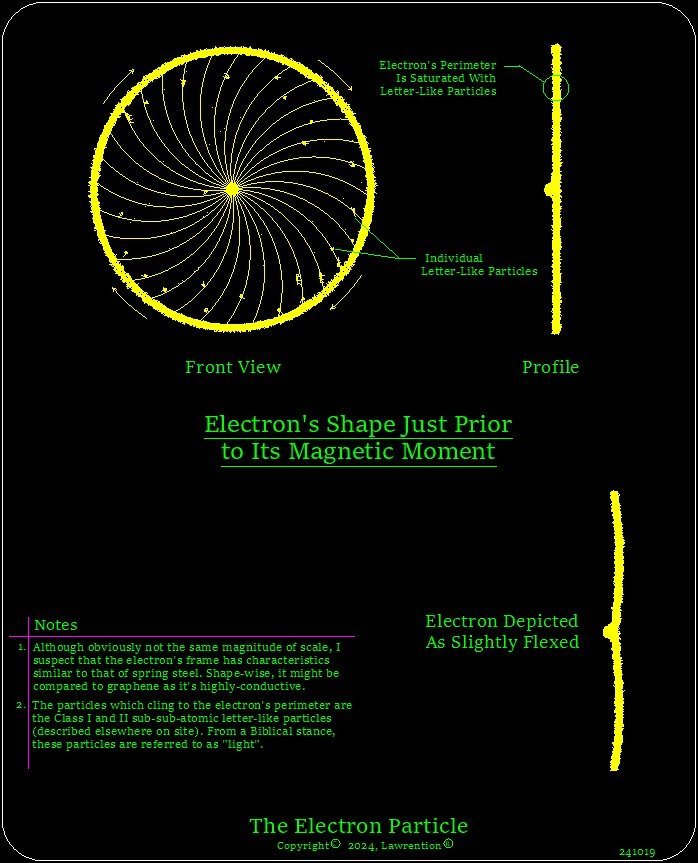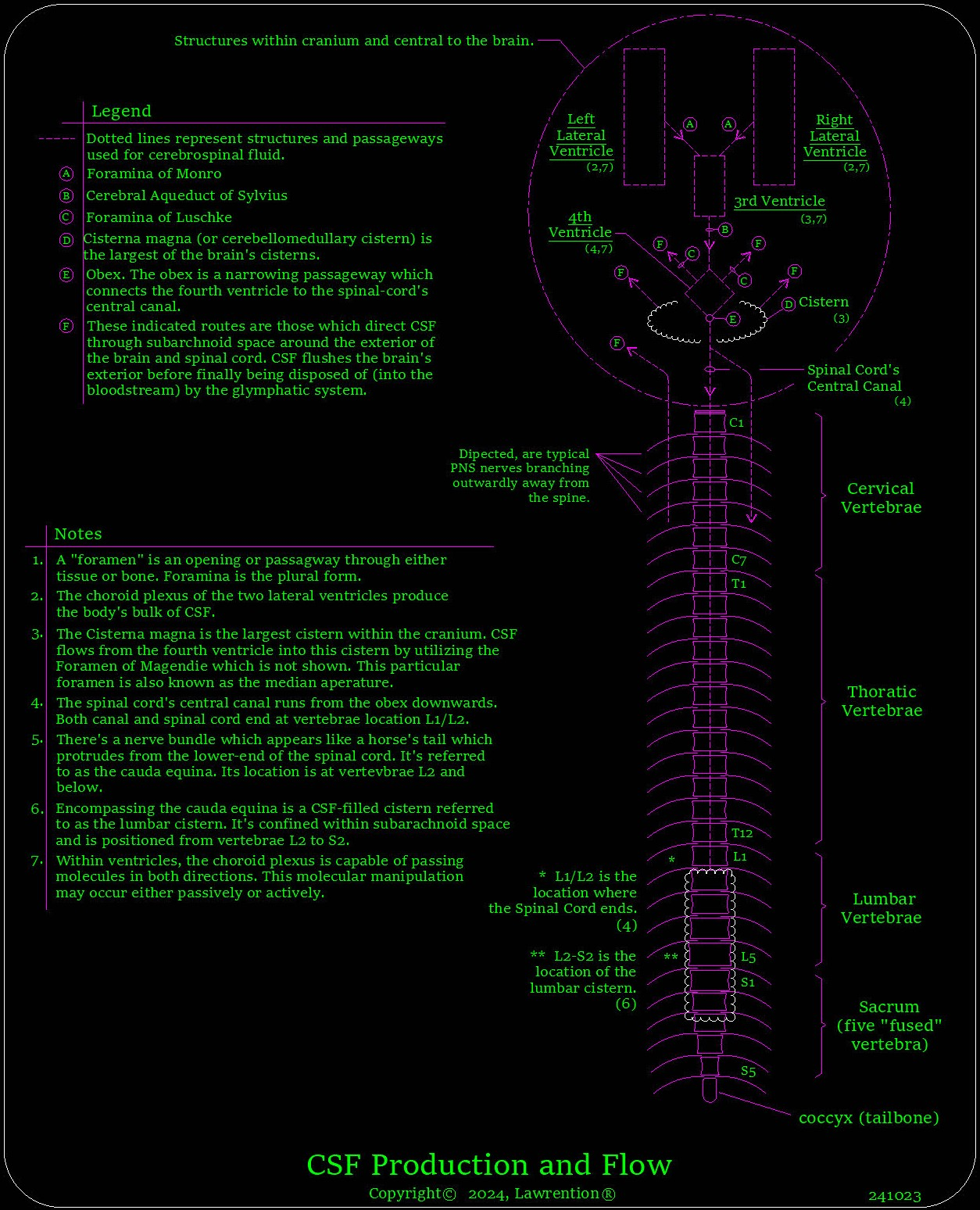The Nurturing Spirit
Of Our Physical Body
Section 5.2
(Published November 2nd, 2024, rev. 241126)
| 🇨🇦 | 🕆 | 🇨🇦 | 🕆 | 🇨🇦 | 🕆 | L🇨🇦 |
Associated Acronym:
• SLLPs - Spiritual letter-like particles.
The Nurturing-Spirit Of Our Physical Body
(5.2 Introduction)
The spiritual-realm expands upon concepts related to the biologically-understood nervous system within the body. In this section, we begin to examine the spiritual world itself in a physical sense.
How I arrived at writing this section was a bit of a journey to say the least. At the end of this section is a picture of an electron itself, and was added to give readers some sense of the spiritual world. The electron drawing is as best I can interpret thus far, as it relates to both shape and function.
I use the following verse as a basis to appropriately frame the link between the spiritual-realm and the physical-realm.
NIV, First Corinthians 15: (46) The spiritual did not come first, but the natural, and after that the spiritual.
To begin examining the spiritual-realm without discussing God himself, is virtually impossible. Within the current study of biology, you're only going to be able to go so deep knowledge-wise, before the mysterious spiritual-realm begins to bubble to the surface. Here, we see that there are biological mechanisms at play which just can't be adequately explained without embracing the spiritual-side of "nature".
Please take for granted that within our world, God is within all things. Why? Well for one, God is a God of order and not one of chaos. A great example of this, is the uniformity of the periodic table of elements; which so happens to be the foundation for much of modern-day science.
NIV, Colossians 1: (17) He is before all things, and in him all things hold together.
5.2.1 Revealing The Spiritual-Realm
Going forward, we begin to show how the spiritual realm manifests itself through physical means. As I can attest, the forthcoming knowledge will take some time to digest - that’s perfectly understandable.
Just to be perfectly clear, I am now speaking about how the spiritual-realm functions within our physical body in a field-like (electrical-magnetic) fashion. We are currently working our way towards the language of the peripheral-nervous-system as a whole, and not towards how or why one might feel or experience thoughts and emotions. Nonetheless, both cases are inexplicably linked.
The spiritual-realm is made up of unfathomably small PARTICLES. We might consider these particles to be like grains of sand, albeit magnitudes smaller. Note that these spiritual-realm particles are sub-components of many of the particles which now comprise the standard-model of particle physics.
The following text includes sub-topics which support our primary theme at hand. These sub-topics may be used elsewhere on this site as well, since they cross a number of disciplines of study. As a result, feel free to glean information from these sub-topics which support our primary-theme-at-hand, and set the rest aside for the time being.
Sub-Topic: Class I and Class II Letter-Like Particles (SLLPs)
(Published 2024, version 241125)
Unbeknownst to secular-based science - it is the contrast between Class I and Class II letter-like particles which gives us colour. These two fundamental classes of particles are perhaps the most primordial particles of all. At least as it relates to our presently-understood universe.
The basis of these two fundamental particle groups comes from a biblical-creation stance; some of which you can see here.
Within the book of Genesis, these two classes of particles are referred to as "Light", and are basically spiritual in nature. Hence, the abbreviation for these spiritual letter-like particles is SLLPs.
I believe that SLLPs are many times smaller than those currently understood within the standard-model of particle physics; including that of neutrinos. For this reason, I refer to them as being sub-sub-atomic in size. I surmise that SLLPs make up a substantial part of all electromagnetic-fields and are the primary reason why we experience such a full and finely grained electromagnetic-spectrum.
From a secular standpoint - it's primarily due to these particles' inherent energy or lack thereof, that differentiates the two classes. Furthermore, the Class I group holds a significantly greater amount of energy than those of Class II, regardless that both classes are similarly sized.
Another way of conceptualizing the energetic difference between these two classes, is to consider that Class I particles are much more efficient within any given environment than those of Class II's. The known particles understood through science are often-times a complementary mix between between these two fundamental classes of matter.
Examples of particles which are heavily based upon the energetic Class-I's are shown below.
- Valence electrons.
- Electrons within the highest quantum-state or states.
- Photons comprised of bright-white light.
- Photons emitted through ionizing radiation.
The utilization of various combinations of Class I and Class II particles results in quite a variety of light intensities and wavelengths which our mind interprets as colour. Colour may not actually be colour at all.... but varying intensities of light and shadows that our mind considers as colour.
Note that photons and electrons which have the ability to hold varying energy states, is a direct result of them obtaining differing ratios of Class I & II particles.
Under the science of biology, there are a number of examples where this underlying mix (ratio) between between these two particle classes comes to "light".
- Depending upon the underlying ratio of Class I & II particles, the primary "currency of energy" (ATP) can can be skewed one way or another. This is a fine-tuning mechanism enabling the currency of classical molecular ATP to be fractionally either raised or lowered. So, energy-wise - all ATP molecules don't necessarily have to be equivalent.
- Electrons of the radical-element fluorine contain a very high ratio of Class I particles, and higher than that of elemental-oxygen.
- Monocytes (white-blood-cells) of the immune system contain a high ratio of Class I particles.
- I believe that stem-cells also contain a very-high ratio of Class I particles.
Using monocytes and stem-cells as prime examples, I like to refer to their underlying ratio of Class I & II SLLPs as an intelligence gradient. I find that this term intertwines nicely with a number of currently-understood biological principles.
Within the book of Genesis, it tells us that we should all be eating our greens. Significantly, the colour green is midway through the visible-light spectrum and represents a balanced ratio of these two fundamental classes of matter.
Moreover, the colour green represents food that's neither ripe nor dead and is still in the process of growing. Nutritionally important, is that a food's colour is more fundamental in nature than the vitamins and minerals by which we often-times use to evaluate them.
Sub-Topic: Electrons are Unique
(Published 2024, version 241125)
As a basis for understanding electrons, consider that they function within a unique environment of spiritual letter-like particles (SLLPs). This is basically a spiritual environment of "light" particles which are sub-sub-atomic in size (sub2-atomic). The environment contains particles magnitudes smaller than an atom, and substantially smaller than the currently understood sub-atomic particles.
Under the discipline of physics, this spiritual environment might be considered to be part of the ether (also spelled as aether); so, it is a major component of the unseen realm. From a biblical-creation stance you can see my basis of reference here.
Further, electrons function within an environment that consists of heterogeneous particle-clouds consisting of SLLPs. These particles comprise the basis for both the spiritual and intelligence aspect of atomic structures.
Within particle physics, electrons are both fundamental and stable particles; so from this stance - they cannot be sub-divided into finer (known) components. Now, from an observational standpoint this may be true; however.... please humor me for a moment and allow me to explain.
What I'm about to reveal here, doesn't change either an electron's mass or its elemental charge of -1. In fact, it reinforces some of its well-understood characteristics. These include the electron's magnetic-moment and having it carry varying energy-states. For this last case, I'm referring to the atomic quantum-states.
Under the electron's hood are particle-like sub-forces which "glue" it together. These sub-forces are comprised of something that looks like numerous-strings which may potentially fan out in multiple directions. At its very center is a solid hub, synonymous to the hub of a spoked wheel.
The electron's "strings" are not loose strings that could go on forever. Nor do I believe that they are sub-components of larger strings, as they are basically discrete groups. Likely the best description that I can give for now, is that the job of each of these discrete grouping of strings, is like that of a primordial seed. So, the center of an electron is essentially one of these seeds.
These primordial seeds are used within a host of standard-model particles. In fact, I believe that these primordial seeds are common to a number (if not most) of the standard-model particles in some form or fashion.
Further, I believe that these primordial seeds manifest themselves through the detection of quarks. Since bare-quarks attract mass and are virtually massless themselves... I believe that bare quarks are often-times synonymous with the vacuum-of-space. Bare quarks are basically primordial seeds. Once mass is garnered though one or more of these seeds (as they can easily be either paired or tripled momentarily), they reveal differing flavours within the quark family.
Although the hub of each electron appears like strings, I am hesitant to name them as such. Primarily since the topic of string-theory is so broad, that likely many of its components just won't apply. That being said, obviously the fundamental notion of strings within particle-physics is quite relevant, as differing lengths of strings accommodate various frequencies via natural rhythms.
Since the electron is so flexible and dynamic, as it mixes with SLLPs - there are various sub-frequencies continually at play. So, if you could listen to an electron in action - it's likely playing a tune.
Swirling about the perimeter of every electron, is a plurality SLLPs. These SLLPs are a homogeneous mix of Class I's & II's. Although both classes are similarly sized, a Class I particle houses more energy than Class II's (as they were created by dissimilar processes). The electron's environment is basically a sea of these sub2-atomic SLLPs.
The electron looks similar to that of a flexible and very wobbly wagon wheel. It has SLLPs rotating about its perimeter, whereby at its center - is its “glue”.
As the electron continuously spins, it’s the letter-like particles sticking to its perimeter which create the bulk of its mass. It continually oscillates within itself as well as within its sub2-atomic environment. Due to its inherent vibrational and dynamic character, it continuously attracts and releases SLLPs.
When an electron becomes “full” of these SLLPs, it is basically saturated of both mass and energy. I believe that at the peak of this saturation point is when it experiences its "magnetic moment".
Once the electron reaches its saturation point, it proceeds to relax. At this stage, it doesn’t attract any more SLLPs; but, in its relaxed state - its continual-spinning motion tends to discard loosely-bound SLLPs. These discarded particles remain free until they become attracted once again by either the same, or a different electron. Once an electron's relaxed state is over - its cycle once again resumes, and attracts further SLLPs.
I believe that electrons quickly oscillate between a fully-relaxed and fully-saturated state. How fast this occurs, relies totally upon their environment. As an analogy.... consider that an electron's change-of-state is its breathing mechanism. So, with every breath...... an electron will inhale and exhale a portion of its environment. As a consequence, electrons continually churn up the sub2-atomic sea. If this was a card game, I would say that electrons serve as a means of continually shuffling the deck of SLLPs.
It's the Class I particles versus those of Class II, which are the most energetic. Likewise, they are also the most intelligent. Because of this, Class I particles typically lead chemical reactions. Here, Class I particles can be considered to be the primary constituent in valence electrons. Whereby, the focus is not upon an atom's nucleus, but its perimeter.
Since each electron is capable of having a differing ratio of Class I & II particles, all electrons are unique. From our much-larger human vantage-point - electrons tend to assume characteristics garnered through by most recent "experience" (or environment).




